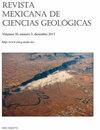Incorporating remote sensing techniques to the DRASTIC index to assess groundwater vulnerability at mining areas: application to Sonora river aquifer, northwestern Mexico
IF 0.5
4区 地球科学
Q4 GEOSCIENCES, MULTIDISCIPLINARY
Revista Mexicana De Ciencias Geologicas
Pub Date : 2022-12-01
DOI:10.22201/cgeo.20072902e.2022.3.1683
引用次数: 0
Abstract
Groundwater metal pollution is a major concern in mining areas. This study proposes a new addition to the DRASTIC method (DRASTIC+Lu) to assess groundwater vulnerability to metal pollution in mining areas by combining remote sensing (to locate metal pollution sources) and the DRASTIC index. The study was performed in a mining area in northwestern Mexico showing current and historical mining activities. The proposed methodology allowed locating known and unknown sources of metal pollution (mining tailings, active/inactive mines, and areas with exposed natural geochemical anomalies). Generally, the addition of the land use (Lu) parameter causes not only a decrease in vulnerability but also highlights very high vulnerable areas and identifies new ones in the vicinity of metal pollution sources. This result is relevant to focus stewardship efforts in very high vulnerable areas. Results allowed to identify the need to implement protection and restauration measures in the Sonora river channel and its vicinity. The proposed method could be implemented in other mining areas around the world –at a low cost– to locate unknown metal pollution sources and clearly identify very high vulnerable areas that play a key role in the protection of groundwater resources.将遥感技术纳入DRASTIC指数以评估矿区地下水脆弱性:在墨西哥西北部索诺拉河含水层的应用
地下水金属污染是矿区的一个主要问题。本研究在DRASTIC方法(DRASTIC+Lu)的基础上提出了一种新的方法,将遥感(定位金属污染源)与DRASTIC指数相结合,评价矿区地下水对金属污染的脆弱性。这项研究是在墨西哥西北部的一个矿区进行的,展示了当前和历史上的采矿活动。所提议的方法允许定位已知和未知的金属污染源(采矿尾矿、活跃/不活跃矿山和暴露的自然地球化学异常地区)。一般来说,土地利用(Lu)参数的增加不仅降低了脆弱性,而且突出了金属污染源附近的高脆弱性区域,并识别了新的脆弱性区域。这一结果与将管理工作重点放在非常脆弱的地区有关。结果可以确定在索诺拉河及其附近实施保护和恢复措施的必要性。所提出的方法可以在世界各地的其他矿区实施-以低成本-定位未知的金属污染源,并明确识别在保护地下水资源中起关键作用的非常高的脆弱区域。
本文章由计算机程序翻译,如有差异,请以英文原文为准。
求助全文
约1分钟内获得全文
求助全文
来源期刊

Revista Mexicana De Ciencias Geologicas
地学-地球科学综合
CiteScore
1.00
自引率
12.50%
发文量
0
审稿时长
6-12 weeks
期刊介绍:
Revista Mexicana de Ciencias Geológicas (RMCG) publishes original research papers on geological processes of broad interest, and particularly those dealing with regions of Latin America. The RMCG also publishes review papers on topics of current interest, and on the geology and tectonics of geological provinces of Latin America. Besides, it offers the opportunity for host editors to publish special thematic issues.
 求助内容:
求助内容: 应助结果提醒方式:
应助结果提醒方式:


